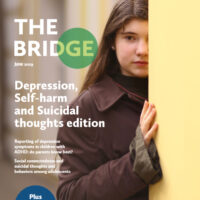Self-harm is an increasingly recognised phenomenon and one of the strongest predictors of suicide, which continues to be one of the leading causes of death in young people world-wide. Self-harm can take many forms and may present with or without suicidal intent and both in the context of mental disorder, and without.
Self-harm & Suicide
-

JCPP Editorial: Volume 60, Issue 10, October 2019
“Suicide and self-harm: advancing from science to preventing deaths” by Joan Rosenbaum Asarnow & Dennis Ougrin
Read more -

Social connectedness is a protective factor against short-term suicide attempts (post discharge) in school children
Researchers in the USA have performed a multi-site, prospective analysis of >2,000 adolescents aged 12-17 years to try to determine the short-term predictors of suicide attempts within 3-months of an emergency department visit. The study population was enriched to include a high proportion of adolescents at risk for suicide attempts.
Read more -

Suicide and Self-harm National Conference
Dr. Dennis Ougrin explains more about his session at our National Conference on Suicide and Self Harm.
Read more -

Effective prevention of suicidal behaviours in adolescents – from targeted treatments to firearms restriction – Professor Lars Mehlum
Professor Lars Mehlum at the launch of the JCPP Special issue 2019 – Suicide and self-harm. Lars looks at ‘Effective prevention of suicidal behaviours in adolescents – from targeted treatments to firearms restriction’
Read more -

Biological explanations of links between childhood adversity and later self-harm: a focus on inflammation – Dr. Abigail Russell
Dr. Abigail Russell at the launch of the JCPP Special issue 2019 – Suicide and self-harm. Abby looks at ‘Biological explanations of links between childhood adversity and later self-harm: a focus on inflammation’
Read more -

In Conversation… Suicide and Self-harm with Professor David Cottrell
David discusses school-based interventions, recent studies on prevention/intervention and (SHIFT), a large multi-centre randomised controlled trial, investigating systemic family therapy following teenage self-harm.
Read more -

How to reduce self-harm in young people – Professor David Cottrell
Professor David Cottrell at the launch of the JCPP Special issue 2019 – Suicide and self-harm. David looks at ‘How to reduce self-harm in young people – Challenges for future research’
Read more -

In Conversation… Suicide and Self-harm with Professor Lars Mehlum
Lars discusses dialectical behaviour therapy for adolescents (DBT-A) as an intervention, his most recent paper in The JCPP, national strategies for suicide prevention and the latest clinical research.
Read more -

-

Depression, Self-harm and Suicidal Thoughts
There are good treatments available for depression, (pharmacological and non-pharmacological) though more options are required to meet the needs of those that do not respond well to treatment. The costs to society, not just the treatment cost but also cost to individuals and wider society including education and employment, are huge.
Read more